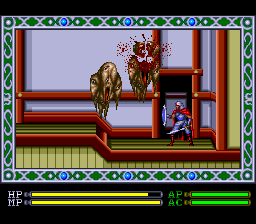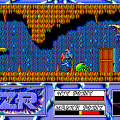Apparently XZR II was released a mere four months after the first game – if this is the case it’s a phenomenal achievement, as XZR II greatly improves upon every aspect of the first game, especially the MSX version. Whereas before it would seem the two games were made by separate teams to create two very different products, the NEC and MSX2 computer versions of XZR II are almost identical, with only the NEC range’s different resolution being the obvious difference. Almost everything has been overhauled, and the MSX2 version now has full multi-directional scrolling in the dungeons, and smoother movement in the overhead maps. Considering the number of MSX2 games which achieved this, it’s all the more impressive. Control is also tighter and more responsive.
Two years later and there were two console ports of XZR II, for the Genesis and Turbo Duo, though full-on remake would be a better description, since pretty much everything was changed: physical structure and design, items available, plot arcs, and so on. Also, the heart-beat monitor style waves were replaced with solid bars that undulated to the right, and drugs have no negative affects. Unsurprisingly, these ports dropped the XZR moniker and were instead titled in Japanese, “Exile: When Trapped Between“. Both were localised for the US. Telenet’s Renovation division handling the Genesis release, and Working Designs handling the Turbo Duo. This was in spite of the fact that it would have been impossible for American audiences to know of the original game. As Vic Ireland told us: “I didn’t know the details of it, but I knew there was another one that had come previously on PC.” Regardless, an intro explained the back story to both versions and players never questioned if they were missing anything. Audibly and visually the games are almost identical, with only an improved font, slightly more colours and spoken dialogue in cut-scenes setting the Duo version apart.
Vic on NeoGAF also explained the atmosphere at the time: “Well, the Turbo Duo (which is all I cared about, doing CD games and all) sold less than 20,000 units. The add-on TG CD drive was that or less. It was really bad, but for the size we were then, we were regularly selling through to 50% or more of the installed base which is incredible and we’ll never match that again.”
XZR II is the jewel in the series, and everyone should play at least one of the versions to completion. Taking place after the events of the first game, Sadler leaves his town to investigate some strangers hanging around near an oasis. This eventually leads him to the Temple of Solomon and head of the Knights Templar, Hugue, who in the localised console ports is searching for the Holimax, possibly a reference to the Holy Grail. In the original computer versions I never spotted either being mentioned, and instead Sadler helps Hugue search for special Mandalas, which are: “concentric diagrams having spiritual and ritual significance in both Buddhism and Hinduism”. Whatever… He needs to find holy artefacts. They travel to France, Rumi gets kidnapped (again), and eventually Sadler heads to India, then visits a Cambodian temple before resurrecting the Manichaean prophet Mani, Next is Japan. After rescuing Ninkan (who in real life was head of Japanese sex cult Tachikawa-ryu), Sadler ends up travelling back in time to the garden of Eden to witness the festival of Bacchus, god of wine. There’s a section involving the murder of real-world Masonic figure Hiram Abiff by The Three Ruffians, Jubela, Jubelo and Jubelum. You fight the third, acquire the Holimax, and then more crazy shit happens before the end.
At least that’s what happens at the end in the console ports. The computer versions were perhaps 20% longer, with several areas set in the future. You start off wandering around present-day Manhattan, take a ride on the subway, fight skateboarding punks and zombies, plus visit St Patrick’s Church and the Rockefeller Centre before popping over to the UN headquarters. Then it’s over to Sikkim, a state within India between Nepal and Bhutan. At the end, after setting in place two of the collected Mandalas, you fight the same boss as in the console ports and finish the game.
There are plenty of other differences between the computer and console versions. The first you’ll notice is that in the opening dungeon the computer versions start Sadler off on the right, facing to the left, and have a door for you to exit via after falling through the false oasis. The console ports start your character on the left facing right (ala SMB), and omit the door. This forces you to stock up on everything before venturing out, though due to differing prices and increased starting funds, it’s possible to buy ample armour and drugs in the console versions. And this resonates for the rest of the game – the computer versions are more difficult and with a non-conventional sense of design, whereas the console ports are considerably easier, flashier, and simplified in their approach. Though both share the same overall themes. If you liked the console versions, you should definitely go and check out the computer originals.
I asked Vic if he spoke with Telenet regarding the computer/console differences. Vic stated: “No discussion with Telenet happened about what happened in the PC->PC Engine port process. We were happy with the game as it was and that was enough!”
The console ports are excellent, and despite the omission of future levels, and are worth playing if you’re new to Exile and want the story in English. There was a partial fan-translation for the MSX2 game, by Django, but this only translated the names of items and keywords. The definitive English version is the Turbo Duo localisation by Working Designs, since it remained uncensored from its Japanese original, whereas the Genesis localisation had the entire burning village removed, as well as the naked dancing girls in the final level. These elements are all still present in the Japanese Mega Drive version though (see screens). The North American TurboGrafx-16 version also has some more difficult enemies, with many having more HP and some dealing more damage.
However, the Duo version did have several names changed. I asked Vic if this was at the request of Telenet. “Not from Telenet, but from NEC. There were very strict rules about religious symbols and names as well as drugs, etc. The weird thing was that they didn’t seem to care so much about people burning at the stake and naked revelry by followers of Bacchus. So we left in the heretic scene and the naked, drunken sprites that were cut from the Genesis version. But other things like the drug references and religious names had to change. Hence, the Christian Crusaders became the Klispin Crusaders. Given the rules from NEC, it was a pretty sensitive subject, so direct references had to be changed.”
More interestingly, is that the major censoring of drug names was done on the Japanese side by Telenet themselves when porting the games. While the computer version of XZR II had pretty much the entire drug selection from the first XZR, if you play the Mega Drive port you’ll find that while dialogue is in Japanese, item names are all in English (making it easy to play through), and most have already been changed to things like convalsents and snake poison. Vic commented: “It was a mixed bag. Some had been changed already, but others were still there. We changed what had to be changed to make it past NEC approval.”
The Genesis version also had some swearing which wasn’t present in the Duo release. This though, Vic explained, wasn’t due to Working Designs: “I don’t remember specifically, but it was probably a case of “chikushou’, which can be translated from “dang’ all the way up to “F***’, depending on translator or context. The Genesis localization sucked anyway. The Engrish was near unintelligible in many places.”
Whichever version you play, Exile is tremendous fun. It’s not very difficult, and there’s not much complexity to it, but there’s just the right balance of action and RPG elements to keep things interesting. Equipment can be bought and sold at stores, but the selection is small and gradually increases, so you never feel like you’ve missing an important item. Health recharges once you’re in an overhead section, and apart from the ant dungeon at the start, there’s never really a need to grind. Screen-filling magic also makes short work of the bosses without you having to get in close. It also looks good, with some minor parallax scrolling and wave effects, plus neat little details in places, like blood splatters on walls, facial portraits for minor characters and so on. Plus, if you’re playing the Duo version, the anime cinemas are voiced, which is cool.
Real-world artist’s impression of Guruda
The music is also extremely good, with some pumping tunes; whether it’s the redbook audio of the Duo version or the chiptunes of the MD version, it’s all excellent. The music for the computer versions of XZR II was composed by Shinobu Ogawa and Tenpei Sato, both long-time Telenet musicians. Taken from the Motoi Sakuraba section on Snesmusic.org: “Being chief composer of Telenet Japan, Shinobu Ogawa did the music for quite a lot of games. His most famous work is Valis, though he also did the sequel, he shared it with one of his past companion, Tenpei Sato. Shinobu also worked together with Nobuhito Koise on a deal of games. Together, they set the standard for the famous “Telenet sound’, which Tenpei Sato, Michiko Naruke, and other later Telenet composers gladly adopted.”
Nothing about Exile is particularly revolutionary, and many will baulk at the simplicity of its disparate elements. But taken as a whole, it’s a nicely made game and very polished, with a unique storyline. It’s unambitious, aiming to do something derivative but do it extremely well. Compared to a lot of other games in 1991, there were some classics and some truly awful releases, and it’s the fact that Exile does nothing explicitly wrong which makes it so charming. A solid little game and definitely worth playing. Now if only it could make it to the Virtual Console or PS3’s new range of PCE games.
XZR II Minigame
To access a sound test in either computer version you press F5 during the intro. But, the PC88 version has a few extra tricks. When you get to the music screen and it says press space, hold on for a second, and instead type in the letters M, A, R, I, N and A, spelling out MARINA. You should hear a sound. Now if you push space the music screen will have additional info, including piano keys at the bottom should you wish to create your own sheet music. But, there’s also a hidden mini game! Like before, type MARINA in, except when you hear the sound, instead of pressing space, type in the following letters M, A, I, T, A, K, A, I, spelling out MAITAKAI, and then press enter. It should take you to a weird game where you control a ball with a really slow turning circle, which has to collect all the P blocks, while avoiding sharp objects. You need to start turning quite early, because the thing handles like an elephant. There’s also a time limit in each stage. It’s extremely difficult, but a nice touch having a hidden game.
Comparison Screenshots – Burning
Comparison Screenshots – Naked Villagers
Comparison Screenshots


